|
|
|
About 800m off the coast of the small village of Anissaras near Hersonissos (Chersónissos) on the Greek island of Crete lies one of the most famous dive sites in the Mediterranean Sea. At the bottom of the Aegean Sea, at a depth of 24m, lays the well-preserved wreckage of a German World War II Messerschmitt Bf 109 fighter. The question is, was the German airplane shot down during "Operation Mercury" in May 1941?
|
|
Due to its geographical location, straddling the border of Europe with Africa and Asia, the Mediterranean island of Crete has always been an important site for foreign powers throughout history. WWII was no different. After the German invasion of Greece, British troops withdrew to Crete to hold the strategic island. For the British, the possession of the island was key for the defense of Egypt and Malta. What’s more, it was also an ideal starting point for naval and air operations against the Greek mainland, the Romanian oil fields of Ploiesti, Iraq and Italy’s crucial supply line from the Black Sea.
|
|
On the early summer of 1941, the German assault on Crete kicked off under the code name "Operation Mercury". The first step was sending a large contingent of German paratroopers to the Cretean settlements of Chania, Maleme, Rethymnon and Iraklion.
|
|
“Operation Mercury" - How Crete became the cemetery of German paratroopers
|
|
Low-flying Ju-52 transporter aircrafts were sent to Crete at dawn on May 20, 1941. Up to 7,000 paratroopers were brought by the transporters to their locations in one day alone. The soldiers were dropped above their operational targets in dense groups. This was the largest airborne operation in the history of war to date. However, the Allies were prepared, and the German soldiers landed in the middle of the Allied defensive forces. After none of the German task forces managed to take a Cretan airfield during the day, the command decided to concentrate all their forces around the Maleme airfield in northwest Crete. In order to take the airfield, the Germans had to tackle one of the island’s most important defensive sites, the nearby Kaukales mount, dubbed the “Hill 107”, which was defended with extreme tenacity by the 22nd New Zealand battalion. During the assault, German bombers (Stukas) continually attacked the small hill to relieve the paratroopers.
|
|
The next day, on May 21, 1941, the first German crews managed to land on the Maleme runway. The runway was still under Allied fire, and the airfield soon started to resemble an aviation cemetery. The remains of the airplanes can still be visited today at a small private museum right next to the Maleme military cemetery. However, the Germans managed to secure the airfield, giving them a strategic edge over the Allies in Crete.
|
|
After the conquest of the Maleme airfield, mountain troopers and other German units arrived with ship transporters from Athens. Altogether some 22,000 German soldiers were deployed. The island was staunchly defended by 42,000 soldiers from Australia, New Zealand, Great Britain, and Greece, but unable to hold the island after heavy fighting, the Allies began to evacuate on the night of 28 May 1941, completing the operation on 1 June 1941. Around 15,000 of their soldiers were captured.
|
|
The Messerschmitt Wreck We See Today
|
|
During the invasion of Crete, the Germans employed many Messerschmitt Bf 109 fighter planes. The aircraft was the first air force fighter with retractable landing gear and the first all-metal aircraft in the world. It would become Germany’s standard fighter plane during the war.
As far as we know, the aircraft just off the coast of Crete is a Messerschmitt Bf-109G-6/U5, essentially the same as the Bf 109 G-5, except for a few different design features; a single-seater fighter with a closed cockpit without a pressurized cabin. A light fighter, 8.94m in length with a wingspan of 9.92m, was developed further to have a new tail fin and larger rudder, making it the most built version of the Bf 109 G series.
|
|
|
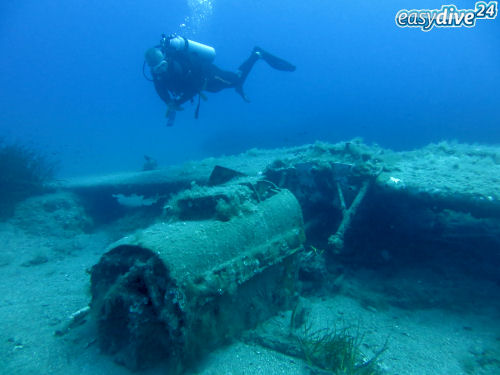 |
|
The biggest change to the previous versions was the installation of a stronger armament above the engine. An MG 131 machine gun was installed in place of the former MG 17, which required more space. This made it necessary to have two large dents in the bonnet, which negatively impacted visibility at the front of the aircraft and created more drag. It was for this reason that the machine soon got the nickname "The Bump". The G6/U5 version was equipped with an on-board armament of 2 x 13mm MG 131s with 600 rounds and a 20mm MG 151/20 with 200 rounds was used for the engine gun.
|
|
Since this type of aircraft wasn’t built until the spring of 1942, such a fighter could not have been shot down during the Battle of Crete. Therefore, it’s more likely that the famed machine that crashed at the end of the Second World War and now lies at the bottom of the Aegean is a fighter aircraft of the squadron "Jagdgeschwaders 27".
Little is known about the cause of the crash. The airplane broke apart when it hit the water and it now lies nose-first, scattered in several parts along the sandy seabed.
|
|
The front of the plane with its engine block, cockpit and wings, rests at a depth of 24m, with the propeller a few meters in front.
|
|
The tail of the machine, the elevator and retracted tail wheel, lies at around 80m behind the fuselage at a depth of 30m.
|
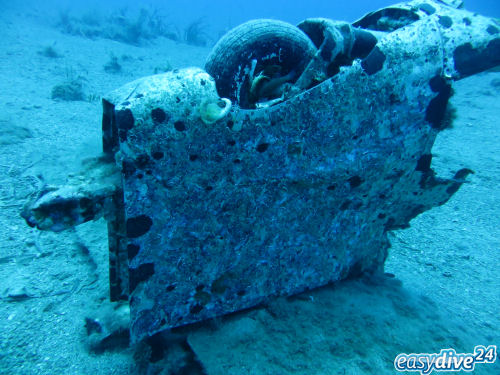 |
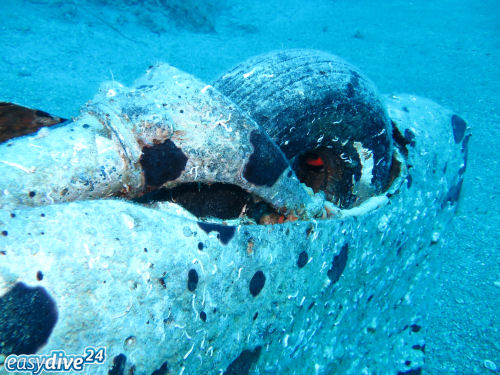 |
|
The wreck is still in astonishingly good condition. The machine gun and on-board ammunition are still clearly visible. During my dive, I found two oxygen tanks at the wreck site, part of the aircraft’s high-altitude respiratory system. Such apparatus aboard the Messerschmitt Bf 109 was made up of a reversible vertical breather and four spherical oxygen cylinders. There are still presumably many other treasures yet to be discovered amongst the wreck, as we try to unravel the site’s history.
|
|
Machine gun, the on-board ammunition and oxygen bottles are still in good condition
|
|
The Legacy of “Operation Mercury”
|
|
The Battle of Crete caused considerable losses on both sides. The German soldiers killed during the campaign were buried in 62 different places around the island. Between 1959 and 1960, the German dead were recovered and buried again, this time together, by the German War Graves Commission (Volksbund Deutsche Kriegsgräberfürsorge e.V.).
|
|
Their coffins were first transferred to the Gonia Monastery in the northwest of the island. They remained there until the expansion of the German military cemetery in Maleme, which began following the Treaty on War Graves signed by Greece and Germany in 1965. For now, this is the final resting place of Germany’s fallen. The cemetery, built on one of the key sites during the battle, "Hill 107", was inaugurated on October 6, 1974. Today, the salvaged bones of 4,465 German soldiers rest there. Three-hundred-and-forty-four casualties were not recovered. Their names have been immortalized on bronze plaques that look out over what is now a peaceful Cretan coastline.
|
|
Source:
Volksbund Deutsche Kriegsgräberfürsorge e.V., Gedenktafeln Soldatenfriedhof Maleme sowie Broschüre, Deutsche Kriegsgräberstätten Griechenland – Versöhnung über den Gräbern – Arbeit für den Frieden
Grignard, Christophe. Shut Down in 1945 Offshore Crete. Wreck Diving Magazine Issue 30 (June 2013)
|
Interesting Facts
The Messerschmitt Bf 109 was the standard fighter of the German Air Force in World War II. It was a cantilevered low-wing aircraft made with a monocoque design. The aircraft’s engineers tried to place the largest possible engine in the smallest possible space. The design is characterized by its closed cockpit, retractable landing gear and an all-metal fuselage and wings. In addition to its low weight and resistance, the creators designed the plane so that it was easy to both produce and repair. The aircraft was built according to a kind of modular principle. This enabled Germany to decentralize the planes’ production and allowed for parts to be easily replaced, which considerably increased their readiness for use in the field. By 1945, a total of seven series had been built, with over 100 versions of the Messerschmitt.
A restored Messerschmitt Bf 109 can be visited in the German Museum of Technology in Berlin.
|
|
Das könnte Sie auch interessieren:
|
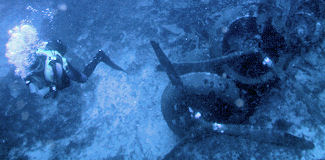
Der bucklige Bomber von Kas (Türkei)
Ein dreimotoriger Mittelstreckenbomber der italienischen Luftwaffe liegt in türkischen Gewässern vor der Küste von Kas. Die Maschine ist vom Typ Savoia Marchetti SM 79 I Sparviero (Sperber), einer der erfolgreichsten Jagdtorpedobomber des Zweiten Weltkriegs, und liegt in einer Tiefe von 57 bis 71 m.
[mehr]
|
|

Die Flugzeugwracks von Renaissance Island (Aruba)
Wrackfans kommen vor Aruba voll auf ihre Kosten. Vor dem Flughafen von Oranjestad liegen zwei gut erhaltene Flugzeugs-Wracks. Nur 300 m vor Renaissance Island befinden sich in nur 12 m Tiefe die Überreste einer Convair CV 240, die angeblich Ende der 1980iger Jahre während einer Drogen-Razzia konfisziert worden war. Nur einige Flossenschläge daneben liegt eine ehemalige Maschine der Air Aruba vom Typ YS-11.
[mehr]
|
|
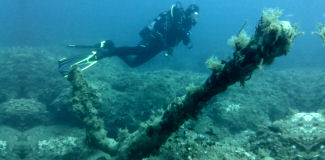
Der Ankerfriedhof von Panormos (Griechenland)
Im Norden Kretas, etwa 25 km östlich von Rethymno, befindet sich das kleine Dorf Panormos. Die Bucht von Panormos beherbergt den bekanntesten Ankerfriedhof des Nordteiles der Insel. Auf dem Meeresgrund liegen in ca. 17 – 24 m Tiefe mehr als ein Dutzend große Anker, von denen die ältesten aus Venezianischer Zeit stammen sollen...
[mehr]
|
|

Tauchen vor Korfu (Griechenland)
Korfu, die grüne Perle unter den griechischen Inseln, bietet abwechslungsreiche Tauchgebiete. Die schönsten sind an der Nordost- und Nordwestküste zu finden. Kleine Gebirge mit Grotten und Höhlen, grasbewachsene Ebenen und große Sandflächen, die so manche Überraschung bergen. Faunatechnisch gibt es viele Brassen, Garnelen, auch mal größere Zackis und immer wieder Muränen.
[mehr]
|
|
Verpasse keinen unserer Artikel mehr und folge uns auch auf Facebook, Youtube, Instagram oder Twitter. Hier gibt’s ständig aktuelle Artikel, Bilder und Videos von unseren Taucherfahrungen und -abenteuern.
|
|
|
|
|
|

